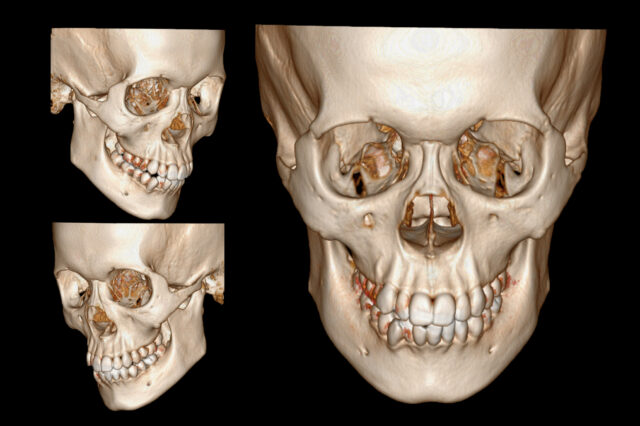Definition
Facial trauma is an injury of the face. It may include the facial bones such as the upper jaw bone (maxilla).
Alternative Names
Maxillofacial injury; Midface trauma; Facial injury; LeFort injuries
Causes
Facial injuries can affect the upper jaw, lower jaw, cheek, nose, eye socket, or forehead. They may be caused by blunt force or be the result of a wound.
Common causes of injury to the face include:
- Car and motorcycle crashes
- Wounds
- Sports injuries
- Violence
Exams and Tests
The health care provider will perform a physical exam, which may show:
- Bleeding from the nose, eyes, or mouth
- Nasal blockage
- Breaks in the skin (lacerations)
- Bruising around the eyes or widening of the distance between the eyes, which may mean injury to the bones between the eye sockets
- Changes in vision or the movement of the eyes
- Improperly aligned upper and lower teeth
The following may suggest bone fractures:
- Abnormal feelings on the cheek
- Irregularities of the face that can be felt by touching
- Movement of the upper jaw when the head is still
A CT scan of the head and bones of the face may be done.
Treatment
Surgery is done if the injury prevents normal functioning or causes a major deformity.
The goal of treatment is to:
- Control bleeding
- Create a clear airway
- Treat the fracture and fix broken bone segments
- Prevent scars, if possible
- Prevent long-term double vision or sunken eyes or cheek bones
- Rule out other injuries
Treatment should be done as soon as possible if the person is stable and does not have a neck fracture.
Outlook (Prognosis)
Most people do very well with proper treatment. More surgery may be needed in 6 to 12 months to correct changes in appearance.
Possible Complications
Complications may include:
- Bleeding
- Uneven face
- Infection
- Brain and nervous system problems
- Numbness or weakness
- Loss of vision or double vision
When to Contact a Medical Professional
Go to the emergency room or call the local emergency number (such as 911) if you have a severe injury to your face.
Prevention
Wear seat belts while driving.
Use protective head gear when doing work or activities that could injure the face.
References
Kellman RM. Maxillofacial trauma. In: Flint PW, Francis HW, Haughey BH, et al, eds. Cummings Otolaryngology: Head and Neck Surgery. 7th ed. Philadelphia, PA: Elsevier; 2021:chap 20.
Mayersak RJ. Facial trauma. In: Walls RM, Hockberger RS, Gausche-Hill M, eds. Rosen's Emergency Medicine: Concepts and Clinical Practice. 9th ed. Philadelphia, PA: Elsevier; 2018:chap 35.
Neligan PC, Buck DW, Facial injuries. In: Neligan PC, Buck DW, eds. Core Procedures in Plastic Surgery. 2nd ed. Philadelphia, PA: Elsevier; 2020:chap 9.

